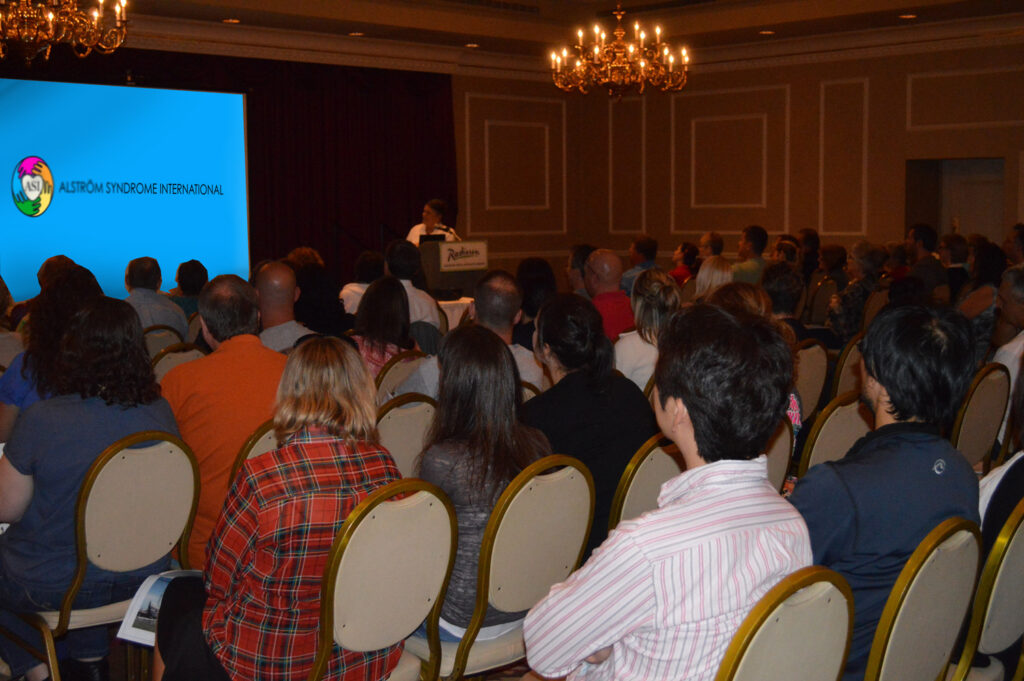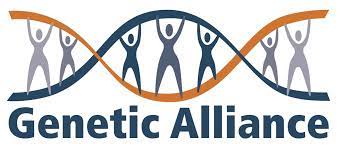By Ellysa Gonzalez
4-year-old Lubbock girl lives with Alstrom Syndrome
 Five-and-a-half months after her daughter Bryce was born, Cassie Johnston began noticing a strange pattern in Bryce’s eye movements.
Five-and-a-half months after her daughter Bryce was born, Cassie Johnston began noticing a strange pattern in Bryce’s eye movements.“Her actual eye balls were wiggling up and down,” Johnston said. “We thought she was having a seizure so we went in to the doctor.”
The doctor referred them to an ophthalmologist. The ophthalmologist advised the family to get an MRI and brace themselves for the result, which he believed to be a brain tumor, Johnston said, adding results showed there was nothing.
This was the beginning of a “diagnosis rigamaroo,” she said.
‘Diagnosis Rigamaroo’
“In two years of doctors thinking they knew what it was, there were nine different diagnosis possibilities,” Johnston said. “More symptoms started to present themselves. She had a vision impairment. She had pneumonia for six months. They were just little pieces of the puzzle.”
The next symptom was weight gain.
“Every time we went in, she was a pound heavier,” Johnston said. “We couldn’t explain how fast she was growing and putting on weight. Nobody knew what it was.”
While they were shadowed in the mystery of her daughter’s condition, Johnston said they began treating Bryce for the individual symptoms.
Doctors at the Retina Foundation in Dallas determined the cause of Bryce’s problems to be genetic, Johnston said.
“Once they confirmed Cone Dystrophy, we knew she had a gene mutation that was at minimum causing her vision impairment,” Johnston said.
She said the cones in the eyes are what allow people to see in the light.
“In bright light, it was like watching a blind person,” Johnston said. “Inside with the lights low, she could get around.”
Therapy, cognitive development
Before Bryce turned 2 years old, she began working with Amy Najjar, an occupational therapist for the Early Childhood Intervention Program in Lubbock and a family friend of the Johnstons.
Najjar’s friendship with Cassie began about eight years ago when her daughter met Paityn, Bryce’s now 10-year-old sister.
When the Johnstons moved away from Lubbock, Najjar said they lost touch. Communication between the families started again when they moved back and had Bryce.
“Their pediatrician recommended therapy for Bryce and recommended me to start seeing them,” Najjar said. “It was difficult to see them having some problem with their little girl and not knowing how it all fit together.”
Najjar said Bryce was withdrawn when they first started working together.
“In the beginning, throughout the time that I worked with her, she had lots of sensory issues, in terms of being overwhelmed, not being able to tolerate people,” Najjar said. “We didn’t know how much vision she did have.”
Najjar had never worked with a child with a disability quite like Bryce’s.
“There are lots of ways I’ve seen similar to her,” she said. “But she had a different diagnosis. She had more medical things as well.”
Bryce seemed to change when she started horse therapy, Najjar said.
“That’s when we saw something really, really change within her,” she said. “She loved the horses. She loved to ride. She started talking and communicating so much. Before, she wasn’t communicating either. I can’t say that was the one thing that did it all; we just saw so many changes. She was interactive. She wanted to play. She started lighting up. Her motor skills had started to get better. She really just started blossoming as a child.”
When Bryce was 3 years old, she stopped seeing Najjar for therapy, but Cassie continued to give her updates on her daughter’s situation.
Search for diagnosis
When Bryce was 2 years old, the Retina Foundation sent her blood samples to Germany for genetic testing.
After countless phone calls to the lab, Johnston said the family had heard nothing about it a year-and-a-half later.
She feverishly Googled Bryce’s symptoms over and over to try to determine the cause of her daughter’s problems, Johnston said.
“My family had a joke,” Johnston said. “They said I’d be the first person to earn an at-home medical degree from Google.”
Nothing she found ever quite fit her daughter’s symptoms until she stumbled across Alstrom Syndrome by chance one Saturday night, she said
Alstrom Syndrome, a disease passed on by a mutated gene from both parents, affects many parts of the body — the heart, vision, hearing, liver, kidneys and more. The first symptoms of Alstrom Syndrome, which are usually noticed in babies, are extreme sensitivity to light and rapid movement of the eyes.
“I saw something I had never seen before,” Johnston said. “ … The timeline of presentation, how the different things presented to her … even a physical look. It was describing Bryce. I thought ‘there’s no way.’ I tried to get more information on it. Everything I read more and more was describing Bryce.”
Najjar said Johnston showed her the results of her search.
“She said ‘doesn’t this look like Bryce?’ ” Najjar said. “She showed me a picture. It was a picture of a different child, but it was her picture. It was her. I said ‘yes, she really does.’ … She said ‘I really think Bryce might have this.’ … I had never heard of this ‘Alstrom Syndrome’ before.”
Johnston joined an exclusive chat group about the disease to see what other families were saying.
“You have to apply and be approved,” Johnston said of the group. “The main question was ‘do you have a child or family member with Alstrom Syndrome?’ ”
Johnston said she gave her reasoning and later received a phone call from Jan Marshall, genetics coordinator for Alstrom Syndrome studies at The Jackson laboratory in Bar Harbor, Maine, and chairwoman of the Alstrom Syndrome International Scientific Advisory Board. Marshall also works with the research team at The Jackson Laboratory that identified the gene responsible for Alstrom Syndrome.
Johnston explained Bryce’s situation and told Marshall about waiting almost a year and a half for the results of her daughter’s genetic testing.
“She said the Alstrom gene is a completely separate gene than any other genetic disease,” Johnston said. “She said they probably were not looking at it. There are only about two labs in the world that can test that gene.”
Two days later, Johnston received a Fed-Ex package with instructions on how to retrieve Bryce’s blood work and send it to a different lab.
“We sent it off to Estonia,” Johnston said. “About eight weeks later, Jan called. She said ‘We found something.’ Bryce’s gene mutation. It just confirmed what we already knew.”
The eight weeks waiting for the results were long for the Johnston family.
“She wanted to know an answer, but she really was scared,” Najjar said of Cassie. “For her and her family, I know it was a mixed reaction. She knew what it was. She could be proactive and know what to do. At the same time, the prognosis was not good.”
In March, they received the confirmation of what they already knew. At 31/2 years old, Bryce was diagnosed with Alstrom Syndrome.
Effects and history
Robert Marshall III, executive director of Alstrom Syndrome International and Jan Marshall’s husband, said he remembers, quite vividly, the night about 21 years ago when his wife got home from work and told him about something she’d read about a rare disease called Alstrom Syndrome.
Jan was persistent about the subject and eventually devoted all her research to the cause of the syndrome and a finding a cure, Marshall said.
Marshall said he never knew much about genes. He said being married to a scientist helped expand his knowledge tremendously.
“It’s always important for people to understand that we all have this gene,” he said. “It’s called the ALMS gene. We all carry it. What happens in our kids is that a mutated copy of this gene is passed down from mom and another is passed down from dad. It’s an autosomal, recessive, inherited, genetic disorder.”
Both parents have to pass down the gene for the child to get the disease, said Marshall. He said statistically, there is a one in four chance of both parents passing on a mutated copy of the Alstrom Syndrome gene to their children, but statistics rarely govern outcomes in life.
“The first and quite terrifying thing that parents usually find out is their kids have a vision problem developing,” he said. “They find out that their child will ultimately go blind. Either just before or just after that, it’s quite common for the child to have an episode of congestive heart failure.”
Some of the children affected by the disease have to have heart transplants before their first birthday, Marshall said.
“As you progress along, your kid ends up getting type 2 diabetes,” Marshall said. “They begin to battle obesity, which is an issue because if you have a plump kids, everybody assumes the parents are doing something wrong. When it’s genetic, you can starve your kid and end up with an overweight child. Usually in early childhood, they begin to lose their hearing.”
The syndrome adds complications like liver failure, pulmonary dysfunction and kidney failure, he said.
“You can treat some of them,” he said. “The diabetes is treated the same way you would treat it in anyone. You can’t make it go away.”
There is not yet a cure, he said, and there are very limited treatments for the multiple organ failure. He said that is part of Jan’s mission as a scientist.
“It is truly one of the meanest, scariest, nastiest genes out there,” he said. “It’s one of the rarest orphan disorders.”
The disease is referred to as an “orphan disorder” because the majority of the money to fund research is from grassroots efforts because it’s so rare, he said.
It’s so rare that despite Lubbock’s status as a medical hub in West Texas, the A-J could find no experts in the area to speak about Alstrom Syndrome.
Symptoms of Alstrom Syndrome were first reported in 1959 by Carl-Henry Alstrom, a Swedish physician describing “retinal degeneration, obesity, sensorineural hearing loss and diabetes” — just a few of the symptoms.
A list of symptoms can be found on the ASI website, said Marshall.
“They can suffer from some, most or all,” he said. “Not everybody gets everything. Virtually nobody gets all of it. … Hearing and vision are pretty much written in stone. There are amazing exceptions. It’s really frustrating that way.”
The Jackson Laboratory website said there are about 800 patients with Alstrom Syndrome spread through 55 countries.
Not every state has somebody affected by the disorder, but the ones that do don’t exceed more than six or seven people at most, said Marshall.
Bryce is one of four in Texas.
Benefit dinner
People with Alstrom Syndrome are often misdiagnosed, like Bryce, said Marshall.
On Feb. 16, the Johnston family will host an Alstrom Angels Benefit Dinner at Four Bar K to help raise money for research toward a cure for Bryce and others like her.
“We have been very blessed and fortunate to be able to be able to financially cover the things she needs,” Johnston said.
The event begins at 7 p.m. and includes four live bands, a barbecue dinner, two raffles and a silent and live auction.
The goal is to raise $30,000. All proceeds will benefit ASI, Johnston said.
“For us, the best way for us to help Bryce is to further the research,” she said. “A cure might not come in her lifetime, but if we can help kids no longer suffer from this one day, then it’s worth it.”
“We’re pretty lucky to get this diagnosis so early,” Johnston said. “A lot of people don’t get diagnosed until they’re in their late teens. For us to know this early, what we can do is try to do preventative treatments.”
Because there is no cure, and few doctors qualified to work with Alstrom patients, Bryce’s doctors just focus on managing her symptoms.
Johnston’s family knows Bryce will eventually lose her vision and they’re preparing her by teaching her to read Braille and how to walk with a stick, she said.
“We won’t be able to stop anything from coming, but we can try to prolong it,” she said. “We don’t know for sure that it will prolong, but we have to at least try and hope that it will help. We hope that maybe it will prolong heart disease by months. It would be worth it. We’re really watching for the medical symptoms.”
By pre-treating the symptoms, Johnston hopes her child can grow up to be as independent as she wishes.
“We just have to accommodate and prepare for what’s to come,” she said. “I know my child is going to be completely blind. It’s emotionally hard. We know the general time frame for when these things will happen.”
The Johnstons try to keep Paityn informed about her younger sister’s condition by sharing the information in an age-appropriate way, she said.
“Paityn is very attentive to Bryce,” Johnston said. “Bryce can get overwhelmed very easily in certain situations. (Paityn) picks up on things that a typical 10-year-old would not. … She’s a pretty amazing little girl. I hate it for her because siblings of children with disabilities have to grow up a lot faster.”
Johnston and her husband act as the sibling support coordinators for ASI.
Aside from Bryce’s disabilities, she is a typical 4-year-old, said her mother, who added some of Bryce’s favorite things include riding horses, swimming and music. Bryce particularly loves songs by Adele, said Johnston.
“She loves music,” Johnston said. “It breaks my heart with the hearing loss. Hopefully the hearing loss will be mild.”
Bryce also loves playing on slides.
“If that child can find a slide, she will go down it,” Johnston said. “God has blessed her with a lack of fear.”
It’s difficult to know what to expect, but she hopes to keep her family’s life as normal as possible, said Johnston.
“We really feel like Bryce is such a blessing,” she said. “She’s such a little angel. She just touches something in everyone. She’s so special and unique. I would have never chosen this for her, but we have been given her this way. Not only is she rare and unique in diagnosis, she really is a unique little person.”





